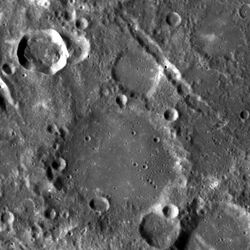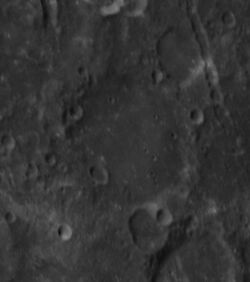Astronomy:Popov (crater)
 LRO image | |
| Diameter | 71.4 km |
|---|---|
| Depth | unknown |
| Colongitude | 261° at sunrise |
Popov is a crater on the far side of the Moon, just beyond the eastern limb. It measures approximately 71.4 kilometers (44.4 miles) in diameter and is located along the very edge of the area of surface that is sometimes brought into view of the Earth during periods of favorable libration and illumination. However even at such times it is not prominent and can only be viewed edge-on.[1]
Description
This crater lies due south of Dziewulski, and the crater chain designated Catena Dziewulski passes just to the northeast of Popov's outer rim. Just to the southeast of Popov lies Möbius, and the two are joined together by a smaller crater that lies along the south-southeast rim of Popov. To the southwest lies the crater Ginzel and Mare Marginis.
Popov is a worn crater with a damaged outer rim that is little more than a circular, jumbled series of ridges in the surface. Several small craterlets lie along the rim and inner wall, particularly along the western side. The interior floor is otherwise relatively level and nearly without any features.
It is named after Russian physicist Alexander Stepanovich Popov, who is considered to be the inventor of radio in his homeland and eastern European countries.[2][3]
Satellite craters

By convention these features are identified on lunar maps by placing the letter on the side of the crater midpoint that is closest to Popov.
See also
- 3074 Popov, asteroid
References
- ↑ "Popov (crater)". Gazetteer of Planetary Nomenclature. USGS Astrogeology Research Program.
- ↑ Schmadel, Lutz D. (2007). "(3074) Popov". Dictionary of Minor Planet Names – (3074) Popov. Springer Berlin Heidelberg. p. 253. doi:10.1007/978-3-540-29925-7_3075. ISBN 978-3-540-00238-3.
- ↑ Smith-Rose, Reginald Leslie (2013). "Alexandr Popov". Encyclopædia Britannica Online. Encyclopædia Britannica, Inc.. http://www.britannica.com/EBchecked/topic/470141/Aleksandr-Popov. Retrieved 6 November 2013.
<ref> tag with name "Moore-2011" defined in <references> is not used in prior text.- Andersson, L. E.; Whitaker, E. A. (1982). NASA Catalogue of Lunar Nomenclature. NASA RP-1097.
- Blue, Jennifer (July 25, 2007). "Gazetteer of Planetary Nomenclature". USGS. http://planetarynames.wr.usgs.gov/.
- Bussey, B.; Spudis, P. (2004). The Clementine Atlas of the Moon. New York: Cambridge University Press. ISBN 978-0-521-81528-4.
- Cocks, Elijah E.; Cocks, Josiah C. (1995). Who's Who on the Moon: A Biographical Dictionary of Lunar Nomenclature. Tudor Publishers. ISBN 978-0-936389-27-1. https://archive.org/details/isbn_9780936389271.
- McDowell, Jonathan (July 15, 2007). "Lunar Nomenclature". Jonathan's Space Report. http://host.planet4589.org/astro/lunar/.
- Menzel, D. H.; Minnaert, M.; Levin, B.; Dollfus, A.; Bell, B. (1971). "Report on Lunar Nomenclature by the Working Group of Commission 17 of the IAU". Space Science Reviews 12 (2): 136–186. doi:10.1007/BF00171763. Bibcode: 1971SSRv...12..136M.
- Moore, Patrick (2001). On the Moon. Sterling Publishing Co.. ISBN 978-0-304-35469-6. https://archive.org/details/patrickmooreonmo00patr.
- Price, Fred W. (1988). The Moon Observer's Handbook. Cambridge University Press. ISBN 978-0-521-33500-3.
- Rükl, Antonín (1990). Atlas of the Moon. Kalmbach Books. ISBN 978-0-913135-17-4.
- Webb, Rev. T. W. (1962). Celestial Objects for Common Telescopes (6th revised ed.). Dover. ISBN 978-0-486-20917-3. https://archive.org/details/celestialobjects00webb.
- Whitaker, Ewen A. (1999). Mapping and Naming the Moon. Cambridge University Press. ISBN 978-0-521-62248-6.
- Wlasuk, Peter T. (2000). Observing the Moon. Springer. ISBN 978-1-85233-193-1.
 |

